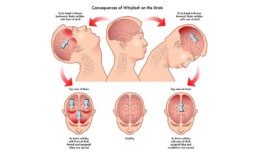In Canada, whiplash accounts for more than $2 million in insurance claims each year that cost the economy about $600 million in lost work productivity, sick leave and medical care.
Let’s take a look at some of the most common questions surrounding whiplash including:
- What is whiplash?
- What does getting whiplash mean?
- How do you know if you have whiplash? What does whiplash feel like?
- How long does whiplash last?
- What is the best treatment for whiplash?
What is whiplash?
The Physiotherapy Association of British Columbia defines whiplash as “an acceleration-deceleration mechanism of energy transfer to the neck. It may result from rear end or side impact motor vehicle collision but can also occur during diving or other mishaps. The impact may result in bony or soft tissue injuries (whiplash injury), which in turn may lead to a variety of clinical manifestations called whiplash-associated disorders (WAD).”
What does getting whiplash mean?
Anatomically speaking, the mechanical forces that occur when the head and neck are whipped forward and back place major stress on the cervical spine. As the head is thrown backward, then forward, the cervical spine is first hyperextended and then hyperflexed; these movements are outside the normal range. The discs can rupture and soft tissue damage can occur. The muscles and ligaments in the neck can become stretched, nerves may be damaged and, in rare cases, bones may break.
Although motor vehicle accidents are the most common cause of whiplash, it can result from a number of other activities that can yield a strong impact on the cervical spine, such as contact sports like hockey, football, rugby and boxing; roller-coaster rides; horseback riding or bicycling accidents. Any direct hit to the head by a large, heavy object may lead to whiplash.

How do you know if you have whiplash?
Whiplash injury symptoms may not appear immediately upon impact. They usually develop within 24 hours of injury, but they may disappear and return after a day or two. They are usually confined to the upper, or cervical, spine and to the middle of the back (thoracic spine), but pain may radiate into the arms, shoulders and head.
If you have whiplash, you may have restricted movement in your neck and your head may feel heavy. Common symptoms include neck stiffness and decreased range of motion; an aching or painful neck or back; fatigue; arm pain and weakness; headaches that generally attack the base of the skull; shoulder pain and stiffness; and jaw pain. The pain is usually dull but may worsen depending on your movements.
Whiplash sufferers may also experience cognitive symptoms as a result of their injuries. You may suffer from ringing in your ears; memory problems; dizziness; difficulty sleeping; irritability; difficulty concentrating; and blurred vision or other visual disturbances.
If your symptoms are painful, spreads to the shoulders or arms, causes numbness or tingling or interferes with everyday activities, you should seek treatments. Medical advice and physiotherapy can help you get back on track.
How long does whiplash last?
When you meet with your physician and with your physiotherapist, it is useful for them to have a catalogue of your symptoms and the movements that create pain.
Generally, it takes about three months for the neck to heal completely, although the pain will subside much sooner.
What is the best treatment for whiplash?
After the initial injury, you may want to ice your neck and consider non-steroidal anti-inflammatory medicine that is available over the counter.
In the past, it was believed that rest was essential to recovery from whiplash and sufferers were given foam neck collars to wear in order to prevent movement. However, it has been demonstrated that this approach does more harm than good; the neck needs to be strengthened in order to aid recovery.
Your physiotherapist will help you strengthen your neck muscles and make them more limber by giving you exercises targeted to your whiplash injury. Not only will this help you heal, but it will make you more resistant to future neck strain.
Starting physiotherapy and its attendant neck exercises as soon after injury as possible will help you recover completely. It will also forestall you from adopting poor posture and overarching your neck to avoid pain. Doing so can create long-term neck problems.
In addition to prescribing a course of whiplash exercises, your physiotherapist may use ultrasound therapy to improve function and decrease pain, while enhancing cartilage repair. Deep tissue massage may be used to treat muscle stiffness that results from the tension that can result from whiplash, and electrical stimulation can assist in relaxing muscles that are tight or having spasms.
As you heal from whiplash, you’ll undoubtedly be eager to prevent it from occurring in the future. If your injury is related to an automobile accident, be sure to buckle your seatbelt when driving and to adjust your headrest to the proper height to give yourself the best chance of avoiding whiplash during an impact.
